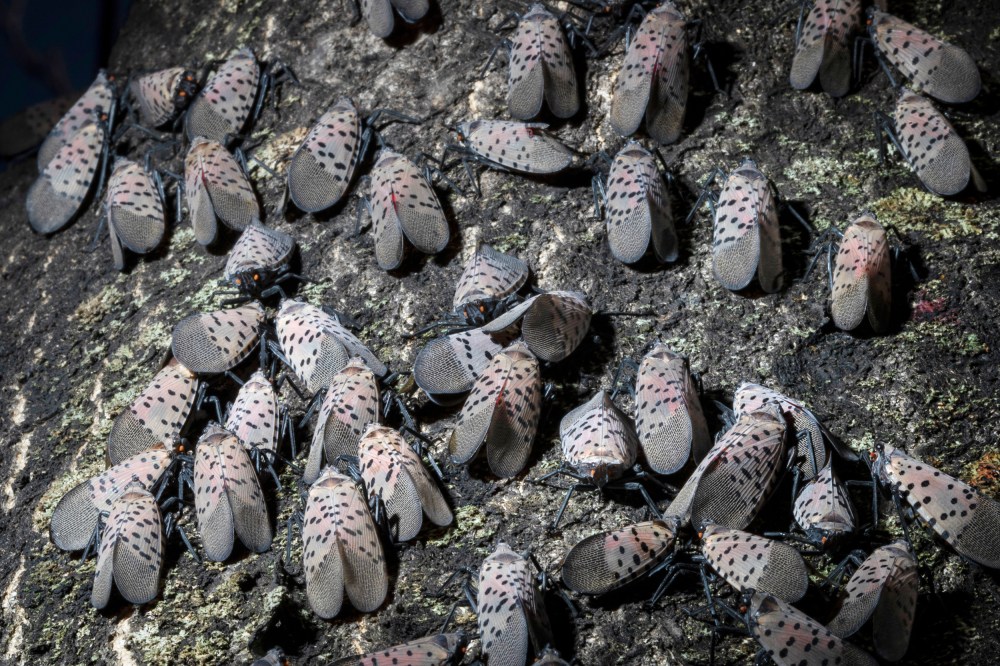I remember that first phone call in mid-September of 2014. A colleague I had not spoken with since graduate school left me a cryptic message, just asking me to call him back. But I immediately knew. The Lycorma had arrived.
If you live in New York City or Pittsburgh right now, you likely have a similar sense of dread today. Lycorma, shorthand for Lycorma delicatula, is the official name of the spotted lanternfly, a member of a group of sap-feeding insects known as “planthoppers.” They crawl up the sides of buildings; they feed at high densities (by the hundreds or even thousands) on single trees, where their sugary excrement, known as honeydew, rains downs on anything below and attracts stinging bees and wasps. Because honeydew is sugar-rich, a sooty mold often grows on it, which visibly blackens trees, understory plants, decking and lawn furniture. They flit around residential neighborhoods, where well-meaning amateur exterminators squash them, leaving piles of carcasses in their wake. They can appear, to the average person, to be a plague. But how bad is this infestation, really? The answer is a little complicated.
I have been involved with the spotted lanternfly threat for the last nine years. It may not seem that way to New Yorkers, but we’ve learned quite a bit in that time.
As an expert on planthoppers, I am familiar with spotted lanternflies. An invasive bug first detected in South Korea in 2004, its feeding was damaging grape vines, fruit trees, ornamental trees and timber, and its presence was an all-around nuisance in residential areas.
American regulators recognized the potential threat, too. Within two weeks of the initial detection in Pennsylvania, the United States Department of Agriculture’s Animal and Plant Health Inspection Service (APHIS) and the Pennsylvania Department of Agriculture assembled a group of scientists to pool our expertise. As one member of that original group, I have been involved with the spotted lanternfly threat for the last nine years. It may not seem that way to New Yorkers, but we’ve learned quite a bit in that time.
Let’s start with the bad news: The spotted lanternfly has already spread widely, resulting in quarantines throughout most of Pennsylvania, as well as areas in New York, New Jersey, Delaware, Maryland, West Virginia, Ohio, Virginia, Massachusetts, Connecticut, Rhode Island, Indiana, Michigan and North Carolina. The spotted lanternfly is also a great hitchhiker that easily latches on to our vehicles and shipments. It has been detected in states like Vermont, New Hampshire, Iowa, Oregon, Washington and California, but is not known to have breeding populations.
It is a significant nuisance pest, feeding on over 70 different species of trees and plants found in North America. With such a broad diet, it tends to move across multiple habitats, feeding on plants across a range of landscapes: agricultural, urban, suburban, managed forests and parks. It can impact a wide range of agricultural and non-agricultural industries, including nurseries, Christmas tree growers, any business shipping goods in or through quarantined areas, and its impacts may change as and if its range continues to expand to new states and regions.

Grape growers so far appear to be the most affected. Based on field observations and research, the available evidence indicates spotted lanternflies feeding at high levels can cause damage and, over time, mortality to grapevines. Damage and impacts in associated industries such as agrotourism have been reported in vineyards in southeastern Pennsylvania and are likely expanding to infested areas in Virginia and New Jersey. Lanternfly populations are now moving closer to important grape-growing areas in New York’s Finger Lakes, Hudson Valley and Long Island regions, as well as vineyards along Lake Erie in Pennsylvania and Ohio.











